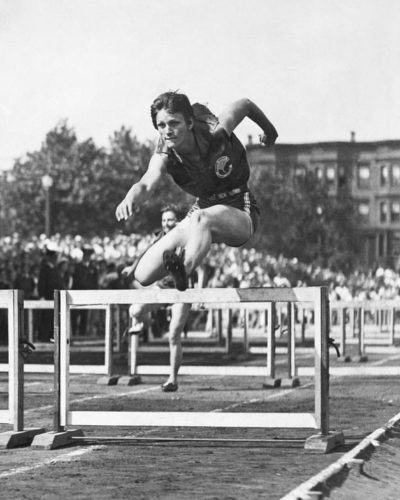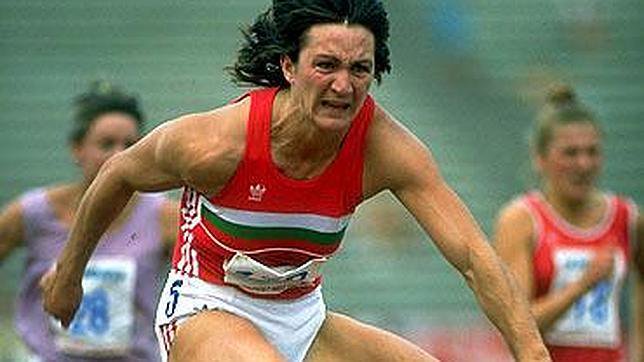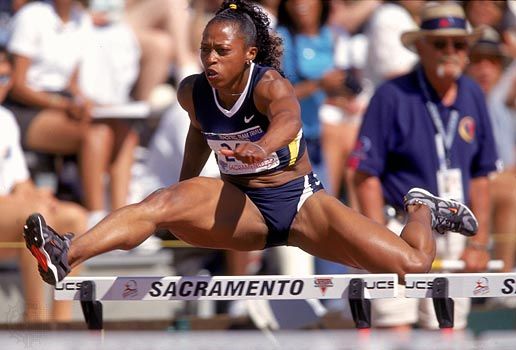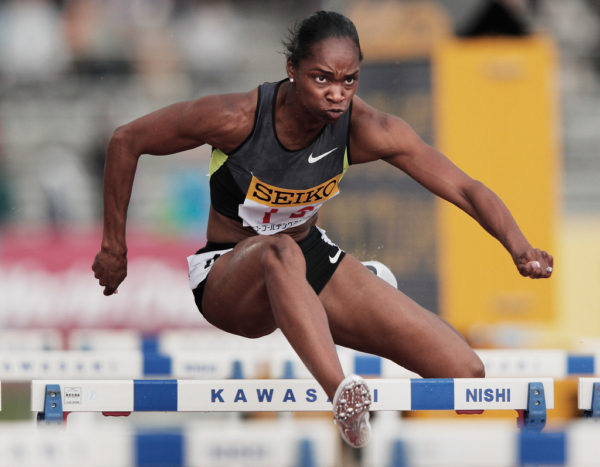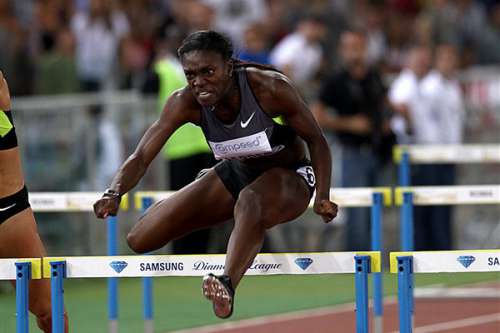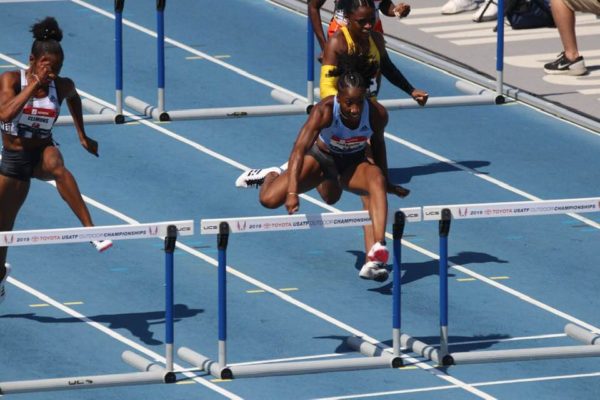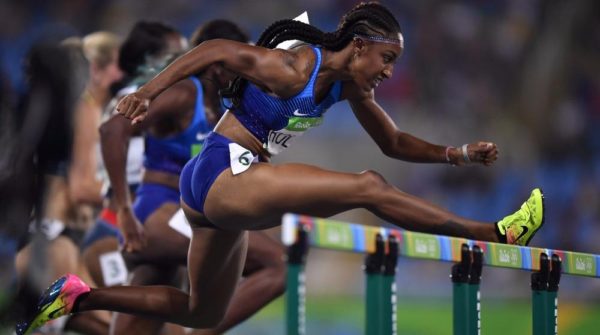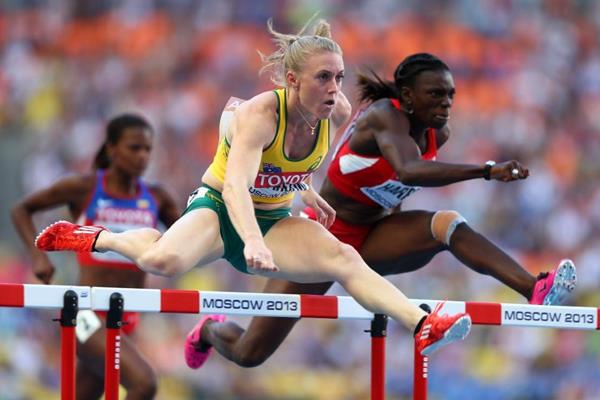History: Women and the Hurdles – 80/100m
by Savannah Cress
Some of the earliest recorded hurdle races took place in the 1830’s. In these events, the athletes would run at the hurdles (which were larger, bulkier and more fixed-in-place than the hurdles used today), jump over, and land squarely on both feet before continuing on. Not unlike many other privileges and opportunities in world history, this event was reserved solely for men. It would be nearly a century, the 1920’s, before women officially entered the hurdling scene, with an 80 meter race. In 1932, the women’s 80 meter hurdle competition was formally accepted into the Olympics, and it was on. [1] [4]
[am4show not_have=’g5;’]
[/am4show][am4guest]
[/am4guest][am4show have=’g5;’]
Mildrid “Babe” Didrikson became the first women’s hurdle Olympic champion at the Los Angeles games. In a mere 11.7 seconds, she secured the gold medal and set a world record for the 80 meter hurdles. [2]
Didrikson, born in 1911 in Port Arthur, Texas, was an impressive competitor in several sports. She grew up playing various sports with her brothers and seemingly excelled at each one. After winning three national basketball championships in high school, she shifted her athletic pursuits to the track. Two years into her study of competitive track, Didrikson competed in an Olympic-qualifying championship meet. To be clear, she didn’t just compete; she single-handedly dominated. [3]
Though a solo-entry who was competing against experienced teams, Didrikson was unfazed. She competed in 8 out of the 10 track and field events at this meet. Of those 8 events, in only 2 did she not come out on top. Her total overall score at this meet, as an independent competitor, was a whopping 30 points, securing her the championship title. The 2nd place team accumulated a total of 22 points…between it’s 22 team members. Domination at its finest. [3]
In the time between the inaugural hurdle competitions and the death of women’s hurdle pioneer Babe Didrikson in 1956 at the age of 45 (due to colon cancer), several tweaks were made to the overall race. The original land-on-two-feet method was wisely ditched. After some experimentation, the now-standard 3-strides-between approach was decided upon. While near the end of the 1800’s the hurdles themselves became lighter and able to fall over once hit, it wasn’t until around 1935 when the L-shape that we know today was adopted. About 50 years into hurdle competitions, the distance of 110 meters became standard for the men’s shorter race. The length of the women’s sprint hurdles race fluctuated a bit in some circuits, but the Olympic Games stuck with the 80 meter distance until 1972, when the 100 meter distance became standard. [4] [5]
The last Olympic 80 meter hurdle event, in 1968, was won by Maureen Caird—a 17-year-old from Australia. The following Olympic Games, when the 100 meter distance became the standard, Annelie Ehrhardt from Germany took the gold. [2] [6] [7]
By the late 80’s, Bulgarian hurdler Yordanka Donkova came into prominence. The years 1986-1988 were quite impressive for her. In that stretch of time, she set five world records in the 100 meter hurdles. Her record of 12.21 seconds, set in 1988, remained the world record all the way up until 2016, when American Kendra Harrison ran 12.20 at the London Muller Anniversary Games. [9]
In addition to her accomplishments on the track, Donkova is admirable for her character, or at minimum, her loyalty. After her glorious campaign in 1988, the United States reportedly attempted to persuade her to run the hurdles branding the US name. She declined the offer, as she was not interested in changing her allegiance from Bulgaria. [9]
Also in the late 80’s, hurdler Gail Devers was making a name for herself. She qualified for the Olympic team in 1988. Unfortunately 2 months later, Devers had some serious, and mysterious, health problems, and her performance in Seoul suffered. She was unable to run times remotely on par for her usual. In her own words, “When I got to the race in the 100-meter hurdles, I ran slower than the first time I ever ran when I ever stepped on the track.” [10]
Devers was losing hair, losing weight, losing strength, and nobody could tell her why. This went on for an agonizing 2.5 years until she was finally diagnosed with an immune system disorder called Graves’ disease. After discovering what was ailing her, Devers could now effectively manage the disease, so she began training again as soon as she regained strength. By the 1992 Olympics, she was back to top form. In the 100h final, she pulled out ahead of the pack and ran a beautiful race, taking a clear lead all the way to the final hurdle, where she caught her lead-leg foot and fell to the ground. Devers went on to compete in five Olympic Games and win three gold medals, though none in the hurdles. [8] [11]
The United States continued to step up its women’s hurdle game once the 2000’s rolled in, claiming at least one of the top 3 medals for 100 meter hurdles in each of the Olympic games held in 2000 and later. [8]
In 2004, Joanna Hayes became the second American ever to win an Olympic gold medal in the 100 meter hurdles, the first being Benita Fitzgerald-Brown in 1984. Hayes ran a 12.37, which set both a personal record and an Olympic record. [8] [12]
American hurdler Michelle Perry ran a 12.66 in the 2005 World Championships, winning the gold medal. Perry successfully defended her title in 2007, bringing her time down to 12.43. [13]
Dawn Harper-Nelson played a vital role in the US’s hurdle Olympic medal streak, winning the gold medal in Beijing, 2008, then the silver in London, 2012. [8]
Prior to her Olympic medals, Harper-Nelson graduated from East St. Louis High School having earned the title of Illinois High School State Champion three different years, in both the 100h and 300h. With six state titles to her name, it’s no surprise that she caught the eye of UCLA track coach, Jeanette Bolden. The fall after high school graduation, Harper Nelson picked up and moved to LA, the city that she would call home for the next 15 years. [14] [15]
At UCLA, Harper-Nelson added several more admirable titles to her 100h resume, including 2003 USA Junior National Champion, Pan American Games Champion, as well as All American at the 2004 NCAA Outdoor Track and Field Championships. Her raw talent and willingness to work hard, along with her contagious enthusiasm, made Harper-Nelson a natural leader and role model, earning her the position of Team Captain her Senior year at UCLA. [14] [15]
In 2006, Harper-Nelson graduated from UCLA and began training with legendary coach Bob Kersee. After undergoing knee surgery in 2008, Harper Nelson ran at the US Olympic Trials in Eugene, OR, where she qualified for her first Olympic Games, in Beijing. In spite of an earlier knee surgery, Harper-Nelson came out wearing the gold medal for the 100h, beating the favored American, Lolo Jones, after Jones clipped the ninth hurdle, moving her position from 1st to 7th. Harper-Nelson’s silver medal came at her second Olympics, in 2012, where she ran a PR of 12.37, surpassing the standing Olympic record of that time. Also in 2012, she earned the title of IAAF Diamond League Champion. This prestigious title was one she would manage to claim each of the following three years as well. Going into the 2015 season, the season of her 4th consecutive IAAF Diamond League Championship, Harper-Nelson was ranked #1 in the world. In the 2016 Olympic Trials, she injured her hip right before the semi-finals and missed qualifying for the finals by a .01 second. [14] [15]
Another dominant American hurdler who disappointingly missed out on the 2016 Olympic team is Kendra Harrison. Harrison came into 2016 very strong. At the Prefontaine Classic meet, she broke the American record and clocked the 2nd fastest time in hurdle world history, with a clean run in 12.24 seconds. Harrison was undefeated in Diamond League races in 2016. By the Olympic Trials, she was clearly a favorite to win the 100h. However, she came in 6th place with a time of 12.62. Two weeks later, at a London Diamond League meet, she not only beat the three athletes who made the Olympic team, but also set a new world record time of 12.20. [16] [17]
With Harper-Nelson and Harrison out of the 2016 Olympic running, Brianna Rollins (who now goes by the last name of McNeal), Nia Ali, and Kristi Castlin represented the United States. The trio did not disappoint, taking an unprecedented gold, silver and bronze medal sweep in the 100h race. Perhaps aiding the Americans in this historical accomplishment was the fact that 2012 Olympic gold medalist Sally Pearson was unable to defend her title due to a hamstring injury. Nevertheless, 2016 was a year for books in American women’s hurdle history. [8]
Pearson, from Australia, discovered her talent and passion for the hurdles at a relatively young age. She participated in Little Athletics Australia as a kid, where, in 1999, Coach Sharon Hannan took notice of 12-year-old Pearson (whose last name was McLellan at the time). Hannan would go on to coach Pearson for the next thirteen years. During that time, Pearson grew immensely as an athlete. The magical irony of this combination is that before the clearly-gifted Pearson joined Hannan’s crew, the coach did not have a whole lot of experience directly with the hurdles. Inspired by coaching a promising young hurdler, Hannan delved into the subject matter and the two of them learned a lot together over the next several years. [18] [19] [22]
Only a couple years after starting with Hannan, Pearson ran her “breakthrough” race, winning the Youth 100m hurdles at the 2001 Austrailian Championships. She had some struggles with a stress fracture the following year, but went on to win the 100h gold at the 2003 World Youth Championships in Canada. [18]
The year following a bad fall at the Commonwealth Games in Melbourne, Pearson broke the Australian 100h record, running a 12.92 in the 2007 National Championship meet in Brisbane. The previous Australian record of 12.93 was set by Pam Ryan in 1972. [18]
In 2011, Pearson won her first World Championship title, in Daegu, South Korea. After setting an Olympic record in 2012, Pearson suffered multiple hamstring injuries in February and May of 2013. She rebounded in time for the Diamond League meet in London, setting a seasonal best. The year 2013 also marked Pearson’s shift from training with Hannan, who had been her sole coach thus far in her hurdling career, to training with Antony Drinkwater-Newman. Drinkwater-Newman had trained alongside Pearson, and then later worked as an assistant coach to Hannan, so there was some historical familiarity there. It wasn’t enough to solidify a bond to mirror that of his predecessor, however, as the very next year, Pearson began training with Ashley Mahoney, who, conveniently enough for Pearson, was also a podiatrist. This relationship proved to be equally fleeting, when in 2016, Pearson made the controversial decision to coach herself. [8] [18] [23]
As unkind as history has been toward self-coached athletes, Pearson did not make the decision lightly. She summoned every angle of experience she had gained during her life on the track, put together a strategic panel of advisors with whom she could discuss and exchange ideas, and spent hours mapping out a training plan to get herself back in a competitive position after a traumatizing fall in 2015 which shattered her wrist, and subsequent hamstring injuries which derailed her Olympic dreams in Rio. [20] [23]
Perhaps because of her unparalleled mental strength and determination, or her years of effective technical training, or the astute awareness of her own physical abilities and limits; perhaps due to some combination of all those aspects, Pearson defied the odds and self-coached herself back from extensive injury to win yet another title at the World Championships in London in 2017. This feat made Pearson exceptionally proud, and rightfully so, due to the surrounding circumstances and undeniable hard work required to bring herself back to the top after nearly two years out from injuries. [23]
That 2017 title will be her last, as during the writing of this article, she announced her retirement from professional track and field. Her announcement caught fans off guard, with the 2019 World Championships just two months away. Sad as it is to realize that Pearson has run her last race, her reason for retiring is straightforward. It goes back to her physical awareness, and respect, for her body’s limits. Having dealt with no less than a half-dozen injuries in the past six months alone, Pearson is realistic when looking ahead to the training required to be ready for world-class competition. She is willing to listen to her body and admit that after sixteen years of intense, brutal, professional-level training, it is time to take a step back. At 32 years old, Pearson has accomplished unfathomable feats, proving to herself, and to the world, what can be achieved with dedication, determination, and a plan. While breaking the news of her retirement via Instagram, Pearson stated, “It has been a long 16 years, but also a fun and exciting 16 years. My body has decided it is time to let it go, and move forward onto a new direction. I hope I have made you proud Australia.” [24] Throughout her career, Pearson has undoubtedly made Australia, and supporters well beyond her home country, proud—something she will likely continue to do in whatever endeavors come next. [21] [24]
From being excluded from the sport at its inauguration, to USA’s 2016 100 meter hurdle Olympic domination, and every world and personal record in between, women of the hurdles have accomplished some pretty exceptional feats. The hard work and determination of these athletes has the ability to ignite inspiration in young girls all over the globe. Some lessons are universal; they transcend any superficial boundaries society has created—age, race, gender, economic status, political viewpoints. In Harper-Nelson’s words: “the journey behind [athletics] can touch people that have never competed before … it’s so much about overcoming obstacles, being knocked down and saying, ‘If I stay here, I will never be all that I’ve been called to be.’” [25]
These women have shown us that, in life as well as on the track, it’s important to run through the hurdles, confronting them head-on, whatever those hurdles may be. We must share knowledge and revelations with others, never underestimating the number of lives we can potentially touch. In turn, we must be open to listening to others’ experiences and discoveries, never underestimating their potential effects. The women of the hurdles have shown us how to focus and practice hard, then let go and trust, both on and off the track.
References:
[1] https://sites.google.com/site/sallypearsonhurdles/the-history-of-hurdles
[2] https://www.athleticsweekly.com/featured/olympic-history-womens-100m-hurdles-47710/
[3] https://www.biography.com/athlete/babe-didrikson-zaharias
[4] https://www.iaaf.org/disciplines/hurdles/100-metres-hurdles
[5] https://en.wikipedia.org/wiki/100_metres_hurdles#Best_Year_Performance
[6] https://en.wikipedia.org/wiki/Maureen_Caird
[7] https://en.wikipedia.org/wiki/Annelie_Ehrhardt
[8] https://www.olympic.org/athletics/100m-hurdles-women
[9] https://en.wikipedia.org/wiki/Yordanka_Donkova
[10] https://www.cnn.com/2013/11/22/health/human-factor-devers/index.html
[11] https://www.sports-reference.com/olympics/athletes/de/gail-devers-1.html
[12] https://www.olympic.org/athletics/100m-hurdles-women
[13] https://en.wikipedia.org/wiki/Michelle_Perry
[14] https://dawnharpernelson.com/bio/#myAnchor
[17] https://ukathletics.com/coaches.aspx?rc=598&path=wtrack
[18] https://sallypearson.com.au/bio/
[19] https://littleathletics.com.au/about-us/
[20] https://www.theguardian.com/sport/2015/jun/15/sally-pearson-hurdles-amputation-rome
[24] https://www.instagram.com/tv/B0zEAUEjAEf/
[/am4show]
